

 |

|
| |
| |
[note added 29 April 2004: This page is now of historical interest only, representing my best efforts to outguess the Boundary Commission whose own Provisional Recommendations are now published at http://www.boundarycommission.org.uk/recommendations.asp. Comments with the benefit of hindsight below.]
The very phrase "Boundary Commission" has significant resonances in Irish history. The 1924-25 Boundary Commission, set up to "determine in accordance with the wishes of the inhabitants, so far as may be compatible with economic and geographic conditions, the boundaries between Northern Ireland and the rest of Ireland", ended by producing a set of recommendations which nobody was willing to support; the result was that Northern Ireland was confirmed within the boundaries of the six counties as established in the Government of Ireland Act, 1920.
However, since then the Northern Ireland parliamentary constituencies for Westminster elections have been subject to the same periodical review as those in England, Scotland and Wales. The changes since 1920 are described in detail on the page of this site reviewing the history of Westminster elections in Northern Ireland; suffice it to say here that the first review, in 1948, split the three two-member constituencies of Antrim, Down and Fermanagh/Tyrone and abolished the Queen's University seat; the second review, in 1970, did some minor tinkering with the Belfast and Antrim seats; the third review, in 1982, increased the number of seats from 12 to 17; and the fourth review, in 1995, added an 18th seat.
The Boundary Commission reviewing the 18 Northern Ireland parliamentary constituencies has now opened its doors for business for the fifth periodical review. It has four members, the chair being the Speaker of the House of Commons, and the other three from Northern Ireland (a judge, a retired civil servant and a businesswoman), and is assisted by the Registrar General for Births and Deaths in Northern Ireland, the Chief Electoral Officer for Northern Ireland, and the Commissioner of Valuation for Northern Ireland. They have now started preparing a set of preliminary recommendations, which will presumably be published later in 2003. If there is any serious demand for further debate (serious being defined as a resolution of a district council, or a petition from 100 voters) the Commission will organise a public hearing, chaired by someone who is not a member of the Commission, in the constituencies concerned. After considering the reports back from the public hearings (which, if any, will probably happen at the end of 2003 and start of 2004) the Commission will produce its Revised Recommendations, probably in mid-2004. These will then be open for a brief period of further public consultation but will not differ much from the Commission's Final Recommendations, which will be presented to Parliament and, while theoretically capable of amendment at that stage, will almost certainly be approved in that form, probably in time for the next Westminster election (due by summer 2006).
The Commission is not taking submissions from the public at this time. This page is therefore an attempt at predicting what the Commission will do, rather than a formal input into the process. Once the Provisional Recommendations have been made, I and many others will hurry to send in our reactions. One can make reasonable guesses about the Commission's approach by reading carefully through the "Explanatory note" posted on their website. The Commission doesn't consider the effect of their recommendations on the actual election results; nor do they consider the effects of demographic shift. The only numbers that they play with are the number of voters on the register on 16 May 2003, and the only building blocks that they play with are the electoral wards (though the Commission are "aware of the desirability of avoiding the division of district electoral areas"). [Added 1 June: The electorate of the wards on 16 May has not been published on the internet, but David Boothroyd pointed me to the figures for 1 May which will not be much different. Updated 10 June: A DUP source tells me that the Commission will work from the 1 May figures rather than the 16 May ones which are not available.]
The Commission has stated that "they would be justified in recommending a number of constituencies other than 17 only to reduce or alleviate difficulties experienced in applying the Rules for the Redistribution of Seats on the basis of 17 constituencies." On the face of it, therefore, it would seem that one of the existing constituencies is for the chop. However, the Rules for the Redistribution of Seats themselves offer a rather obvious let-out from this presumption. The Rules, in the Commission's summary, are:
Now it's fairly clear that since the "electoral quota" is arrived at by considering the current 18 seats, any credible 18-seat configuration is going to produce seats closer to this figure than any credible 17-seat configuration, so Rule b (and to a certain extent also Rule d) actually work towards the maintenance of the 18 seats; and Rule c was invoked by the previous Commission to get us to the current 18-seat situation. [note added 29 April 2004: Indeed, the Boundary Commission admitted as much in their Provisional Recommendations.] Having said that, the current position is that the four Belfast seats are all around 15% below the 18-seat electoral quota, and together make up 3.35 electoral quotas at 18 seats - 3.17 electoral quotas if you go back to 17 seats. At first sight, therefore, it seems fairly likely that Belfast will lose a seat. I will explain below why I don't believe this is likely.
- so far as is practicable having regard to other Rules, no wards shall be included in one constituency and partly in another. No wards are currently divided between constituencies [and it's difficult to see how they would be - NW];
- constituency electorates should be as near the electoral quota as is practicable having regard to other Rules. The Commission may depart from the strict application of (a) if it appears desirable to avoid an excessive disparity between any constituency electorate and the electoral quota or between the electorate of any constituency and that of neighbouring constituencies. The electoral quota is the average number of electors and is found by dividing the total number of parliamentary electors in Northern Ireland by the number of existing constituencies [original emphasis - NW];
- departures from the strict application of (a) and (b) are permissible if special geographical considerations including, in particular, the size, shape and accessibility of a constituency appear to render a departure desirable; and
- although not under a duty to aim at giving full effect in all circumstances to the above Rules, the Commission shall take account, so far as they reasonably can, of the inconveniences attendant on alterations of constituencies (other than alterations made for the purpose of avoiding wards being divided between constituencies) and of any local ties which would be broken by such alterations.
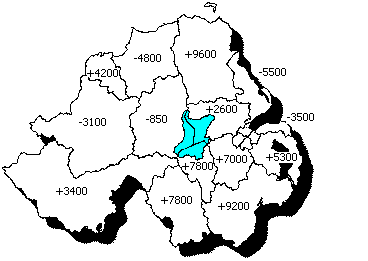 First,
though, the easy bit. In the western half of Northern Ireland, the five
constituencies of the former counties of Londonderry, Tyrone and
Fermanagh,
I make the daring prediction that the Boundary Commission will
recommend
no changes at all. Mid Ulster is the closest of all 18 seats to the
current
electoral quota, and the deviations of the others are not great - Foyle
is 4,200 voters (6.9%) too large, Fermanagh and South Tyrone is 3,400
too
large (5.5%), West Tyrone 3,100 too small (5.1%), and East Londonderry
4,800 too small (7.9%). On the raw figures alone one might consider
transferring
a couple of rural Derry wards to East Londonderry to even up the
difference
but when you look at the map it doesn't really make a lot of sense. (If
that were to happen though, Foyle could become a borough rather than a
county constituency as most of its rural element would have
disappeared.)
Transferring wards from Fermanagh to West Tyrone makes no sense at all.
First,
though, the easy bit. In the western half of Northern Ireland, the five
constituencies of the former counties of Londonderry, Tyrone and
Fermanagh,
I make the daring prediction that the Boundary Commission will
recommend
no changes at all. Mid Ulster is the closest of all 18 seats to the
current
electoral quota, and the deviations of the others are not great - Foyle
is 4,200 voters (6.9%) too large, Fermanagh and South Tyrone is 3,400
too
large (5.5%), West Tyrone 3,100 too small (5.1%), and East Londonderry
4,800 too small (7.9%). On the raw figures alone one might consider
transferring
a couple of rural Derry wards to East Londonderry to even up the
difference
but when you look at the map it doesn't really make a lot of sense. (If
that were to happen though, Foyle could become a borough rather than a
county constituency as most of its rural element would have
disappeared.)
Transferring wards from Fermanagh to West Tyrone makes no sense at all.
[note added 29 April 2004: Almost right; the Commission did indeed recommend the transfer of two rural Derry wards to East Londonderry, but the other three western constituencies were left alone.]
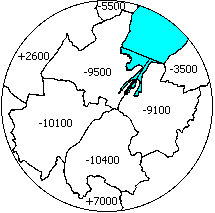 In
the eastern half of Northern Ireland, the four Belfast seats are all
around
15% below the electoral quota and another five seats - North Antrim,
Lagan
Valley, Upper Bann, Newry and Armagh, and South Down - are all more
than
10% over the quota. The most important question the Boundary Commission
will have to address is whether or not to reduce the four Belfast seats
to three, and then whether or not to create a new seat in County Down.
I will make another daring prediction, which is that the Boundary
Commission
will keep Belfast at four seats. The four current seats total 205,000
voters,
39,000 short of the combined quotas for four seats and only 22,000 over
the combined quotas for three. But I think the Commission will prefer
to
add sufficient bits and pieces around the edges of the city to bring
all
four current seats within spitting distance of the magic 60,969 rather
than engage in the huge restructuring of Northern Ireland's electoral
geography
that the alternative would require.
In
the eastern half of Northern Ireland, the four Belfast seats are all
around
15% below the electoral quota and another five seats - North Antrim,
Lagan
Valley, Upper Bann, Newry and Armagh, and South Down - are all more
than
10% over the quota. The most important question the Boundary Commission
will have to address is whether or not to reduce the four Belfast seats
to three, and then whether or not to create a new seat in County Down.
I will make another daring prediction, which is that the Boundary
Commission
will keep Belfast at four seats. The four current seats total 205,000
voters,
39,000 short of the combined quotas for four seats and only 22,000 over
the combined quotas for three. But I think the Commission will prefer
to
add sufficient bits and pieces around the edges of the city to bring
all
four current seats within spitting distance of the magic 60,969 rather
than engage in the huge restructuring of Northern Ireland's electoral
geography
that the alternative would require.
[note added 29 April 2004: This was an accurate prediction, though I was wrong on many of the details.]
I have two reasons for thinking this. The first has to do with the geography inside Belfast. The four Belfast seats currently each contain between 11 and 14 Belfast wards, with electorates of around 3,000, and make up the numbers with wards from neighbouring districts, most of which are at or below 2,000 electors. To turn four seats of around 51,000 voters into three seats of around 68,000, you have to transfer at least 17,000 electors from two donor seats into two recipient seats and then merge what remains of the donor seats. (Or a more complex permutation). That is, five or six wards in Belfast, or more if wards outside Belfast come into play.
It seems basically unlikely that the Lagan estuary will be straddled by any constituency, so if Belfast does lose a seat, the two recipient constituencies must therefore be North and East Belfast, and the remnants of South and West Belfast will be merged into a new Belfast South-West seat. But this is where it gets difficult. It's fairly easy to see what would go from South Belfast to East Belfast - the Woodstock, Ravenhill, Ballynafeigh and Rosetta wards of Belfast, with 12,000 voters, and some or all of the neighbouring Castlereagh wards of Galwally, Newtownbreda, Cairnshill and Knockbracken which together have 7,500 voters. That would put the enlarged East Belfast in the right ballpark.
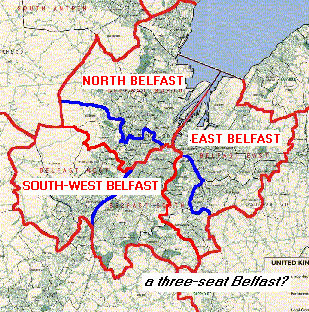 The
problem is on the other side of town. Transferring the first three
wards
from West Belfast to North Belfast is not difficult - the five Shankill
wards have been rather unnaturally split between the two constituencies
since 1982, and so shifting the 7,900 voters of Highfield, Glencairn
and
Shankill will raise few eyebrows (indeed the previous Boundary
Commission
recommended this as part of their three-seat Belfast plan). But to even
up the numbers, three more wards need to be shifted (the wards in
inner-city
Belfast are underpopulated anyway and were further slimmed down by the
new electoral registration system). The obvious ones to move are Falls,
Clonard, and Beechmount with 8,100 voters, just enough to make North
Belfast close to the right size. This would detach the heart of
republican West Belfast
from the rest of the Falls Road and insert it into an enlarged North
Belfast
seat. It is difficult to predict whether Nigel Dodds or Gerry Adams
will
be more dismayed by this prospect but it can safely be guaranteed that
neither would be happy.
The
problem is on the other side of town. Transferring the first three
wards
from West Belfast to North Belfast is not difficult - the five Shankill
wards have been rather unnaturally split between the two constituencies
since 1982, and so shifting the 7,900 voters of Highfield, Glencairn
and
Shankill will raise few eyebrows (indeed the previous Boundary
Commission
recommended this as part of their three-seat Belfast plan). But to even
up the numbers, three more wards need to be shifted (the wards in
inner-city
Belfast are underpopulated anyway and were further slimmed down by the
new electoral registration system). The obvious ones to move are Falls,
Clonard, and Beechmount with 8,100 voters, just enough to make North
Belfast close to the right size. This would detach the heart of
republican West Belfast
from the rest of the Falls Road and insert it into an enlarged North
Belfast
seat. It is difficult to predict whether Nigel Dodds or Gerry Adams
will
be more dismayed by this prospect but it can safely be guaranteed that
neither would be happy.
[Added 5 September: Eugene McDermott emails to point out that in fact transferring that number of voters from West to North Belfast still leaves enough SF votes in even a new South-West Belfast constituency to make it a safe SF seat, and shifts the balance in North Belfast to the point where it becomes a viable proposition for SF. I've checked his figures and in fact he's quite right; a three-seat Belfast does give SF a reasonable chance of two seats out of three. I think my prediction about Nigel Dodds' likely reaction remains valid though...]
That would leave the new South-West Belfast constituency a very uncomfortable hybrid of the mid and upper Falls, on the one hand, and the famous leafy suburbs of the Malone Road, on the other. Even if the Boundary Commission were to put this scheme forward in its preliminary recommendations, I can't see it surviving a round of public enquiries. When the previous Boundary Commission produced its initial recommendations for the fourth periodical review in 1994, they actually did propose the option of three Belfast seats within the boundaries of Belfast City Council. The local inquiry in Belfast, lobbied particularly strongly by Sinn Féin and the DUP, recommended very firmly that the four seats should be retained, with the strength of community links between West Belfast proper and the Twinbrook/Poleglass areas of Lisburn being a primary concern - ie that the Lower Falls and Twinbrook are more closely tied than the two sides of the M1. The then Boundary Commission accepted the recommendation under Rule c, and most would admit that it is a fair point. In the event of the current Boundary Commission recommending that Belfast be reduced to three seats, and that the Lower Falls be partitioned between North and South-West Belfast, we can expect a similarly vigorous campaign.
That's the argument from the internal geography of Belfast. The second argument stems from the geography of the rest of County Antrim. If the Boundary Commission does one thing outside the immediate Belfast area, it must be to reduce the size of the bloated North Antrim constituency, which has the largest electorate in Northern Ireland at 70,582. Coincidentally, this is almost exactly the same amount over the quota (9,613) as North Belfast is below the quota (9,547). Surely it will attract the Boundary Commission to use the one to compensate the other, with knock-on effects in the two constituencies in between?
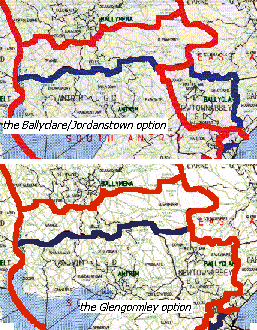 The most likely
surgery on North Antrim - whose periphery is composed of sparsely
populated,
awkwardly shaped rural wards - is for its boundary with South Antrim to
shift four or five miles north, losing Grange, Kells and Glenwhirry
with
their roughly 6,000 electors. That would take North Antrim back down to
only 3,500 over the electoral quota, which is probably acceptable. Of
course,
it adds those 6,000 voters to South Antrim which is already 2,600 in
excess.
The most likely
surgery on North Antrim - whose periphery is composed of sparsely
populated,
awkwardly shaped rural wards - is for its boundary with South Antrim to
shift four or five miles north, losing Grange, Kells and Glenwhirry
with
their roughly 6,000 electors. That would take North Antrim back down to
only 3,500 over the electoral quota, which is probably acceptable. Of
course,
it adds those 6,000 voters to South Antrim which is already 2,600 in
excess.
[Added 1 June: Robert Adair writes suggesting that the Glens of Antrim will be shifted from North to East Antrim. I actually proposed this to the last Boundary Commission between the Revised and Final Recommendations, and the reasons they gave for rejecting it then still seem sound: it's only 4,000 electors, who basically look much more to Ballycastle than to Larne, let alone Carrickfergus or Newtownabbey.]
[note added 29 April 2004: Robert Adair was right, and I was wrong; but I will be surprised if a public enquiry sustains the idea that Ballycastle is politically closer to Jordanstown than to Ballymena.]
[Added 3 October: David Ford points out that If the Belfast boundary was not breached, South Antrim could remain unchanged with a small area of Ballymena (6,000 electors in Broughshane, Slemish and Glenwhirry wards) transferring from North to East Antrim. It's a blow for my theory and another strike for Eugene McDermott's point on the three-seat Belfast.]
South Antrim will therefore have to lose some electors as well. The two possibilities I can see are that it might lose Ballyclare to East Antrim, inevitable if North Belfast gets only a modest expansion into Jordanstown, or that it might lose Glengormley to North Belfast - a fairly massive shift that would pave the way for North Belfast to shed the two Shankill Road wards it currently includes. In either case it's around 11,000 voters which would leave the constituency around 2,500 under quota, a respectable variation. If East Antrim gained Ballyclare and lost Jordanstown it would be around a thousand voters larger, so an acceptable 4,500 under the quota; otherwise it would stay as it is, 5,500 under the quota. I think the second of these two options is the more likely for reasons explained below.
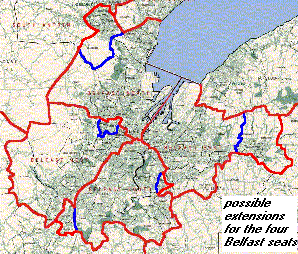 The most complex
calculations involve the raft of constituencies from Newry and Armagh
to
North Down, including the three other Belfast constituencies. Let's
start
with West Belfast, which is a massive 10,100 votes short of the quota
and
unlike South Belfast does not have much to choose from outside the city
boundaries as potential additional material. In fact the only serious
prospects
are two or three of the Dunmurry wards from Lisburn: Dunmurry, Seymour
Hill and perhaps Derryaghy. It's possible - the three together are
7,300
voters and even without Derryaghy would be 4,000 - but I think it's
more
likely that the two Shankill Road wards of Woodvale and Crumlin will be
transferred from North Belfast, bringing 5,000 voters with them (of
course
this is only possible if North Belfast extends to Glengormley rather
than
Jordanstown), and taking West Belfast to an acceptable 5,000 short of
the
quota.
The most complex
calculations involve the raft of constituencies from Newry and Armagh
to
North Down, including the three other Belfast constituencies. Let's
start
with West Belfast, which is a massive 10,100 votes short of the quota
and
unlike South Belfast does not have much to choose from outside the city
boundaries as potential additional material. In fact the only serious
prospects
are two or three of the Dunmurry wards from Lisburn: Dunmurry, Seymour
Hill and perhaps Derryaghy. It's possible - the three together are
7,300
voters and even without Derryaghy would be 4,000 - but I think it's
more
likely that the two Shankill Road wards of Woodvale and Crumlin will be
transferred from North Belfast, bringing 5,000 voters with them (of
course
this is only possible if North Belfast extends to Glengormley rather
than
Jordanstown), and taking West Belfast to an acceptable 5,000 short of
the
quota.
[note added 29 April 2004: I called this one wrong. The bizarre splitting of the Shankill between two constituencies is upheld in the Commission's Provisional Recommendations, and the three Lisburn wards added to West Belfast.]
That would also leave Dunmurry and Seymour Hill available to fill the gap for South Belfast, which is the smallest of the existing constituencies at 10,400 short of the electoral quota, and which otherwise has only the geographically implausible possibilities of Carryduff North and South (total 4,100 electors) or perhaps one or two other Castlereagh wards currently in East Belfast. East Belfast itself must surely expand to take in four Dundonald wards, almost 8,000 voters, enough to see it comfortably near the quota from its current 9,100 deficit, even if it loses a ward or two to South Belfast from inside the dual carriageway.
[note added 29 April 2004: I got this half right. As the Dunmurry wards go to West Belfast, South Belfast does indeed extend to take in both Carryduff and two East Belfast Castlereagh wards from inside the dual carriageway, and East Belfast expands to take in not four but five Dundonald wards.]
 For the rest
of County Down, the key point is the bloated South Down constituency,
at
70,173 almost as oversized as North Antrim and 9,200 over the quota.
The
problem is, all four adjoining constituencies are pretty bloated as
well
- Newry and Armagh by 7,800, Upper Bann also by 7,800, Lagan Valley by
7,000 and Strangford by 5,300. My previous suggestions for South and
East
Belfast took 4,000 out of Lagan Valley and 8,000 out of Strangford but
that still leaves some ground to make up.
For the rest
of County Down, the key point is the bloated South Down constituency,
at
70,173 almost as oversized as North Antrim and 9,200 over the quota.
The
problem is, all four adjoining constituencies are pretty bloated as
well
- Newry and Armagh by 7,800, Upper Bann also by 7,800, Lagan Valley by
7,000 and Strangford by 5,300. My previous suggestions for South and
East
Belfast took 4,000 out of Lagan Valley and 8,000 out of Strangford but
that still leaves some ground to make up.
A minimal solution would be to just shift Kilmore and Crossgar with 4,000 voters from South Down into Strangford, bringing South Down to 5,200 over quota, Strangford 1,300 over and leaving the others as they are. That has the attractive feature of reuniting the whole Rowallane district electoral area in a single parliamentary constituency. It still leaves Newry and Armagh, and Upper Bann, more than 12% over the quota, which may be felt to be a tolerable deviation.
[note added 29 April 2004: I was too unimaginative here. Adding not just Kilmore and Crossgar but a couple of other wards to Strangford gave the Commission a bit more wiggle room in the south-east.]
If the Commission does feel it has to trim down the two remaining large constituencies, the knock-on consequences become rather large. There's not much trimming to Newry and Armagh that really makes sense - perhaps shifting the 3,700 voters of Tandragee and Laurelvale to Upper Bann and that's about it. You would then have to shift the 10,000 Banbridge Town DEA voters to South Down, and then South Down would have to give most of the 13,000 voters of the Downpatrick DEA to Strangford, which in turn would have to shed the 12,000 Ards Peninsula voters to North Down, which would probably then have to lose three Holywood wards with 5,200 voters to East Belfast.
[note added 29 April 2004: I didn't spot the half-way house of restoring the boundary around Newry to the pre-1983 line, and adding Ballynahinch to Strangford, with a couple of wards trimmed off Upper Bann for Lagan Calley and South Down.]
The alternative - which can only really happen if Belfast has been reduced to three seats - is to take Banbridge from Upper Bann and Newry town from Newry and Armagh, move both into South Down, and use Downpatrick, Ballynahinch and Dromore as the nucleus of a new East Down constituency. This is effectively what the previous Boundary Commission proposed in its Preliminary recommendations, a scheme that was howled down with outrage by Seamus Mallon of the SDLP in particular, though it had filled nobody with enthusiasm, and which the local inquiry in Newry firmly rejected (see the exchanges on the subject in the Dail in February 1994 and in the House of Lords in November 1995). Perhaps the current Boundary Commission will try and repeat its predecessors' plan, but I am inclined to doubt it.
The one thing that might prod them in that direction is the consideration that each constituency now elects six members of the Northern Ireland Assembly. The two previous Boundary Commissions had the discretion to recommend different numbers of Assembly seats per constituency, but in fact both eventually recommended five each (though the variation in constituency size in the Final Recommendations on both occasions was more than 10% above and below the average). The decision to increase from five seats to six per constituency was a political one made in the closing hours of negotiations on Good Friday 1998. I would suspect that since the current Boundary Commission has not been given any direction about the Assembly it will choose to ignore the issue, and go for the scheme outlined above of extending the four Belfast constituencies outwards with some fairly minimal consequential changes in Counties Antrim and Down.
[note added 29 April 2004: On the big picture, at least I got it right. The details will take another year to work out, I suspect.]
See also: The Boundary Commission's Provisional Recommendations | Jim Riley's analysis of votes and seats in the 1998 Assembly election | Gerrymandering | The constituencies | The political parties | The NI Executive | Useful books and links
Results from 1996 to 2001 for each seat: East Belfast | North Belfast | South Belfast | West Belfast | East Antrim | North Antrim | South Antrim | North Down | South Down | Fermanagh and South Tyrone | Foyle | Lagan Valley | East Londonderry | Mid Ulster | Newry and Armagh | Strangford | West Tyrone | Upper Bann
Surveys of each recent election: 2004 European | 2003 Assembly | 2001 Westminster | 2001 local govt | 2000 S Antrim | 1999 European | 1998 Assembly | 1997 local govt | 1997 Westminster | 1996 Forum | 1995 N Down | 1994 European | 1993 local govt | 1992 Westminster | 1989 European | 1989 local govt | 1987 Westminster | 1986 by-elections | 1985 local govt | 1984 European | 1983 Westminster | 1982 Assembly | 1981 local govt | 1979 European | 1979 Westminster | 1977 local govt | 1975 Convention | Oct 1974 Westminster | Feb 1974 Westminster | 1973 Assembly | 1973 local govt | Summary of all Northern Ireland elections since 1973 | Brief summary of election results 1997-2003
Historical pieces:Westminster elections 1885-1910 | The 1918 election | Dáil elections since 1918 | Westminster elections since 1920 | Senate of Southern Ireland 1921 | Irish Senate elections in 1925 | Northern Ireland House of Commons | Northern Ireland Senate | The 1973 and 1975 referendums
Other sites based at ARK: ORBiikkkuoiuokiuk (Online Research Bank) | CAIN (Conflict Archive on the INternet) | Northern Ireland Life and Times Survey
Front page | Site Map | Notes and Queries | Updates Mailing List | About this site
Your comments, please! Send an email to me at nicholas.whyte@gmail.com.
Nicholas Whyte, 31 May 2003; updated 29 April 2004
|
Disclaimer:©
Nicholas Whyte 1998-2004 Last Updated on Wednesday, 12-Jan-2005 12:12
|